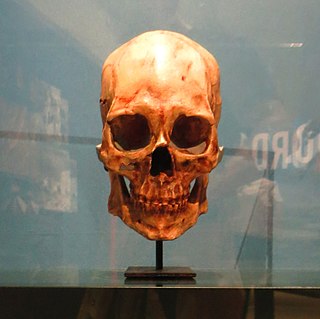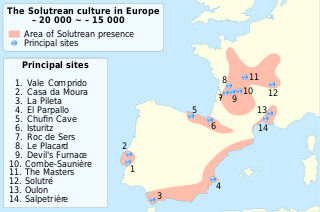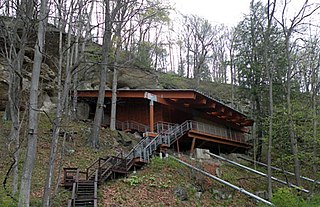Related Research Articles

Kennewick Man, or the Ancient One, is the name generally given to the skeletal remains of a prehistoric Paleoamerican man found on a bank of the Columbia River in Kennewick, Washington, United States, on July 28, 1996. It is one of the most complete ancient skeletons ever found. Radiocarbon tests on bone have shown it to date from 8,900 to 9,000 calibrated years before present, but it was not until 2013 that ancient DNA analysis techniques had improved enough to shed light on the remains. In June 2015, it was announced that Kennewick Man had the most genetic similarity among living peoples to Native Americans, including those in the Columbia River region where the skeleton was found.

The Solutrean industry is a relatively advanced flint tool-making style of the Upper Paleolithic of the Final Gravettian, from around 22,000 to 17,000 BP. Solutrean sites have been found in modern-day France, Spain and Portugal.

Clovis points are the characteristically fluted projectile points associated with the New World Clovis culture. They are present in dense concentrations across much of North America; in South America, they are largely restricted to the north of that continent. Clovis points date to the Early Paleoindian period, with all known points dating to the 600 years between roughly 13,500 to 12,800 calendar years ago. Clovis fluted points are named after the city of Clovis, New Mexico, where examples were first found in 1929 by Ridgely Whiteman.

The Clovis culture is a prehistoric Paleoamerican culture, named for distinct stone tools found in close association with Pleistocene fauna at Blackwater Locality No. 1 near Clovis, New Mexico, in the 1920s and 1930s. It appears around 11,500–11,000 uncalibrated years before present (YBP) at the end of the last glacial period and is characterized by the manufacture of "Clovis points" and distinctive bone and ivory tools. Archaeologists' most precise determinations at present suggest this radiocarbon age is equal to roughly 13,200 to 12,900 calendar years ago.

Meadowcroft Rockshelter is an archaeological site located near Avella in Jefferson Township, Washington County, Pennsylvania, United States. The site is a rock shelter in a bluff overlooking Cross Creek, and contains evidence that the area may have been continually inhabited for more than 19,000 years. If accurately dated, the site would be the earliest known evidence of human presence and the longest sequence of continuous human occupation in the New World.
Cactus Hill is an archaeological site in southeastern Virginia, United States, located on sand dunes above the Nottoway River about 45 miles south of Richmond. The site receives its name from the prickly pear cacti that can be found growing abundantly on-site in the sandy soil. Cactus Hill may be one of the oldest archaeological sites in the Americas. If proven to have been inhabited 16,000 to 20,000 years ago, it would provide supporting evidence for pre-Clovis occupation of the Americas. The site has yielded multiple levels of prehistoric inhabitance with two discrete levels of early Paleoindian activity.

The Solutrean hypothesis on the peopling of the Americas claims that the earliest human migration to the Americas took place from Europe during the Last Glacial Maximum. This hypothesis contrasts with the mainstream view that the North American continent was first reached after the Last Glacial Maximum, by people from North Asia, either by the Bering land bridge, or by maritime travel along the Pacific coast, or by both.

The Eva site (40BN12) is a prehistoric Native American site in Benton County, Tennessee, in the Southeastern United States. Located along an ancient channel of the Tennessee River, the Eva site saw extensive periods of occupation during the Middle and Late Archaic period. The site's well-defined midden layers helped investigators identify three distinct Archaic cultures, the oldest of which was first identified at Eva and is still known as the "Eva culture" or the "Eva phase."

The archaeology of Iowa is the study of the buried remains of human culture within the U.S. state of Iowa from the earliest prehistoric through the late historic periods. When the American Indians first arrived in what is now Iowa more than 13,000 years ago, they were hunters and gatherers living in a Pleistocene glacial landscape. By the time European explorers visited Iowa, American Indians were largely settled farmers with complex economic, social, and political systems. This transformation happened gradually. During the Archaic period American Indians adapted to local environments and ecosystems, slowly becoming more sedentary as populations increased. More than 3,000 years ago, during the Late Archaic period, American Indians in Iowa began utilizing domesticated plants. The subsequent Woodland period saw an increase on the reliance on agriculture and social complexity, with increased use of mounds, ceramics, and specialized subsistence. During the Late Prehistoric period increased use of maize and social changes led to social flourishing and nucleated settlements. The arrival of European trade goods and diseases in the Protohistoric period led to dramatic population shifts and economic and social upheaval, with the arrival of new tribes and early European explorers and traders. During the Historical period European traders and American Indians in Iowa gave way to American settlers and Iowa was transformed into an agricultural state.
Pendejo Cave is a geological feature and archaeological site located in southern New Mexico about 20 miles east of Orogrande. Archaeologist Richard S. MacNeish claimed that human occupation of the cave pre-dates by tens of thousands of years the Clovis Culture, traditionally believed to be one of the oldest if not the oldest culture in the Americas.

The Gobero archaeological site, dating to approximately 8000 BCE, is the oldest known graveyard in the Sahara Desert. The site contains important information for archaeologists on how early humans adapted to a constantly changing environment. Gobero is located in the Ténéré desert of Niger, and is named after the Tuareg name for the region. It is the type site of the Holocene era Kiffian culture and Tenerian culture.

The Goodall Focus was a Hopewellian culture from the Middle Woodland period peoples that occupied Western Michigan and northern Indiana from around 200 BCE to 500 CE. Extensive trade networks existed at this time, particularly among the many local cultural expressions of the Hopewell communities. The Goodall pattern stretched from the southern tip of Lake Michigan, east across northern Indiana, to the Ohio border, then northward, covering central Michigan, almost reaching to Saginaw Bay on the east and Grand Traverse Bay to the north. The culture is named for the Goodall Site in northwest Indiana.
Buttermilk Creek Complex refers to the remains of a paleolithic settlement along the shores of Buttermilk Creek in present-day Salado, Texas dated to approximately 15,500 years old. If confirmed, the site represents evidence of human settlement in the Americas that pre-dates the Clovis culture.

Douglas W. Owsley, Ph.D. is an American anthropologist who is the current Head of Physical Anthropology at the Smithsonian's National Museum of Natural History (NMNH). He is widely regarded as one of the most prominent and influential archaeologists and forensic anthropologists in the world in some popular media. In September 2001, he provided scientific analysis at the military mortuary located at Dover Air Force Base, following the 9/11 attack in Washington D.C. The following year, the US Department of Defense honored him with the Commander's Award for Civilian Service for helping in the identification of 60 federal and civilian victims who died when American Airlines Flight 77 hit the Pentagon.

The Riverside Site, also known as 20-ME-1, is an archaeological site located near the Riverside Cemetery in Menominee, Michigan. It was listed on the National Register of Historic Places in 1978.
Haplogroup Q-Z780 is a subclade of the Y-DNA Haplogroup Q-L54. Q-Z780 is defined by the presence of the Z780 Single Nucleotide Polymorphism (SNP).

The Hidden Valley Rockshelter (44-BA-31) is a significant archaeological site located near the community of Warm Springs in Bath County, Virginia, United States. A large rockshelter located near the Jackson River, it has been occupied by humans for thousands of years, and it has been named a historic site.
Anzick-1 is a Paleo-Indian male infant whose remains were found in south central Montana, United States, in 1968, and date to 12,707–12,556 years BP. The child was found with more than 115 tools made of stone and antlers and dusted with red ocher, suggesting an honorary burial. Anzick-1 is the only human who has been discovered from the Clovis Complex, and is the first ancient Native American genome to be fully sequenced.
Humans have inhabited Quebec for 11,000 years beginning with the de-glaciated areas of the St. Lawrence River valley and expanding into parts of the Canadian Shield after glaciers retreated 5000 years ago. Quebec has almost universally acidic soils that destroy bone and many other traces of human activity, complicating archaeological research together with development in parts of southern Quebec. Archaeological research only began in earnest in the 1960s and large parts of the province remain poorly researched.

Soro Mik'aya Patjxa is a high-altitude archaeological site located in the Ilave Basin in Peru, about 30 km (19 mi) west of the current shoreline of Lake Titicaca. Soro Mik'aya Patjxa was a seasonal residential site that was reused consistently by hunter-gatherers over a period of over a thousand years.
References
- ↑ Ancient Man in North America. Denver Museum of Natural History, Popular Series No. 4. H.M.Wormington, 1949.
- 1 2 From Kostenski to Clovis: Upper Paleolithic-Paleo-Indian Adaptations. Edited by Olga Soffer and N.D. Praslov. Plenum Press, 1993.
- 1 2 Owsley, Douglas; Hunt, David; Macintyre, Ian; Logan, Amelia (May 2001). "Clovis and Early Archaic Crania from the Anzick Site (24PA506), Park County, Montana". Plains Anthropologist. Maney Publishing. 46 (176): 116–7. doi:10.1080/2052546.2001.11932062. JSTOR 25669710. S2CID 159572593.
- 1 2 New Radiocarbon Dates for the Clovis Component of the Anzick Site, Park County, Montana in Paleoindian Archaeology- A Hemispheric Perspective. University Press of Florida by Juliet Morrow and Stuart Fiedel, 2006.
- ↑ Clovis and Early Archaic Crania from the Anzick Site (24PA506), Park County, Montana, Plains Anthropologist, 46 (176): 115-124, Douglas Owsley and David Hunt, 2001.
- 1 2 Homeland: An Archaeologist’s View of Yellowstone Country’s Past. Cayuse Press, Box 1218, Livingston, Montana. Larry Lahren 2006.
- ↑ The Wilsall Excavations: An Exercise in Frustration. Proceedings of the Montana Academy of Sciences. 29:147-150, D.C. Taylor 1969.
- ↑ The Anzick or Wilsall Site: A Clovis Complex Burial in the Shields River Valley of Southwestern Montana. Paper presented at the Annual Meetings of the Society for American Archaeology, Norman, Oklahoma. 1971, Larry Lahren.
- ↑ Bone Foreshafts from a Clovis Burial In Southwestern, Montana. Science 186: 147-150. Larry Lahren and Robson Bonnichsen, 1974.
- https://opi.mt.gov/Portals/182/Page%20Files/Indian%20Education/Social%20Studies/9-12/Investigating%20the%20First%20Peoples%2C%20The%20Clovis%20Child%20Burial.pdf
- Genetic Roots of the First Americans. Jennifer Raff and Deborah a. Bolnick. Nature 506, 162–163. 2014.
- White, Samuel Stockton V. 2015. M.A. Thesis: "The Anzick Site: Cultural Balance and the Treatment of Ancient Human Remains (Toward a Collaborative Standard)". Theses, Dissertations, Professional Papers, Missoula, MT: University of Montana ScholarWorks, Graduate School.
- White, Samuel Stockton V. 2019 Ph.D. Dissertation "THE ANZICK ARTIFACTS: A HIGH-TECHNOLOGY FORAGER TOOL ASSEMBLAGE" (2019). Graduate Student Theses, Dissertations, & Professional Papers. 11338.
